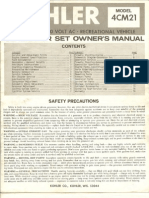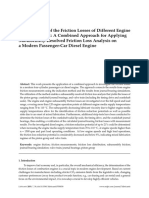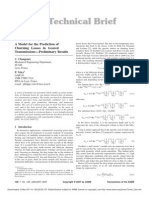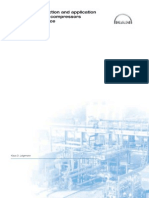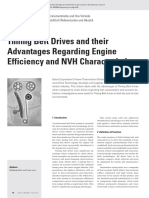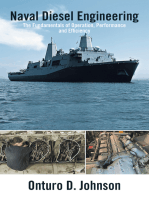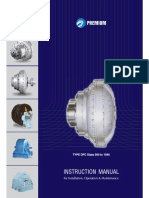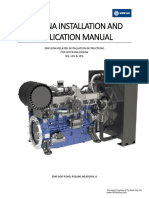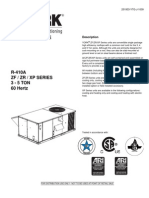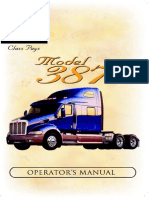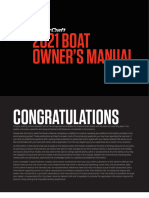Characterization of The Ring Pack Lubricant and Its Environment
Characterization of The Ring Pack Lubricant and Its Environment
Uploaded by
Avinash GamitCopyright:
Available Formats
Characterization of The Ring Pack Lubricant and Its Environment
Characterization of The Ring Pack Lubricant and Its Environment
Uploaded by
Avinash GamitOriginal Description:
Original Title
Copyright
Available Formats
Share this document
Did you find this document useful?
Is this content inappropriate?
Copyright:
Available Formats
Characterization of The Ring Pack Lubricant and Its Environment
Characterization of The Ring Pack Lubricant and Its Environment
Uploaded by
Avinash GamitCopyright:
Available Formats
109
Characterization of the ring pack lubricant and its
environment
P J Burnett, MA, PhD, B Bull, CEng, MIMechE and R J Wetton, MSc, CChem, MRSC
Shell Research Limited, Thornton Research Centre, Chester
The performance characteristics of the piston ring-liner assembly and the lubricant within it are critical for the operation of modern
internal combustion engines. The ring pack can directly affect engine friction, oil consumption and oil degradation, which in turn can
impact upon fuel economy, emissions and engine wear. The operation of this system is complex and no single technique is capable of
fully characterizing the processes occurring. This paper outlines the range of both experimental and theoretical methods that are being
applied to the study of this system and the lubricant within it. These include the modelling of ring pack gas and oil flows, and direct
measurement of piston temperatures, ring belt pressures and piston ring motion. Characterization of lubricant degradation via direct
sampling of oil from the top ring groove of an operating engine has also been used. The merits of such a multi-faceted approach are
discussed in relation to piston deposit formation.
K e y words: ring pack, fuel economy, emissions, engine wear, lubricant degradation, piston ring-liner system, engine performance
1 INTRODUCTION
The physical and chemical stresses found within a
piston ring pack are possibly the most aggressive that
the lubricant will be subjected to in an internal combustion engine. This environment is characterized by
high temperatures, high gas pressures, acidic combustion products, thin and highly loaded oil films and a
physically inaccessible location within the engine.
However, performance of the piston ring-liner system is
arguably the most critical of any of the engine
assemblies. The piston ring pack is the interface
between the combustion and lubrication systems, and
its efficiency both as a gas seal and as a dynamically
loaded sliding bearing have a direct influence on the
efficiency of the engine as a whole.
There is increasing interest in the performance of the
piston ring-liner system as a result of environmental
pressure. Legislation already exists for tailpipe emissions of oxides of nitrogen (NOx),unburned hydrocarbons (HC) and particulate emissions (soot) from diesels.
Most of these emissions are directly related to the fuel
and combustion characteristics of the engine. However,
it has been shown that there may be a small but significant contribution from the lubricant to both HC and
particulate emissions-this being believed to be linked
to the level of oil consumption of the engine. Consequently, engine manufacturers have made hardware
changes to dry up the ring pack and hence reduce oil
consumption.
Fuel economy is also being targeted by the legislators, for air quality in North America and for the greenhouse effect in Europe. The lubricant properties, in
particular the friction between the piston ring and liner,
have a significant role to play here.
Finally, emissions legislation commonly includes a
durability target, with heavy-duty diesel engines being
required to remain within the emissions limits over
hundreds of thousands of miles without major overhaul.
This paper was presented a? an international conference on Experimental and
predictive methods in engine research and development held in Birmingham on
17-18 November 1993. The M S was received on 19 July 1994 and was accepted
for publication on 4 November 1994.
J02094
Clearly, to meet this requirement, the engine oil needs
to protect the piston rings and liner against wear and
prevent deposit build-up on the pistons-both of which
can affect the performance of the ring pack.
Clearly, then, the performance of the engine oil in the
piston ring-liner system is critical in determining the
overall performance of an engine and may play an
active role in meeting engine emission and fuel economy
targets. If the factors that will make a good lubricant in
this environment are to be fully understood, it is essential to first characterize that environment. This paper
describes a combination of experimental and predictive
techniques that have been used to gain insights into
both the physical processes governing the transport of
oil and gases within the ring pack and the characterization of some aspects of oil degradation in the ring
pack using the top ring groove oil sampling techniques
developed in the authors laboratory (1, 2). The studies
focus on a supercharged single-cylinder diesel engine.
2 ENGINE DESCRIPTION
Experimental and predictive modelling studies were
carried out on a pair of supercharged, indirect injected
single-cylinder Caterpillar lY73 engines, with a swept
volume of 2.2 litres. The piston used is normally fitted
with three compression rings (top ring barrel faced,
second and third rings taper faced) and a single-piece,
twin-land oil control ring. For certain experiments the
piston was run with only two of the compression rings
fitted.
The predictive modelling techniques used require a
detailed description of the geometry of the piston and
the rings when fitted in the bore. These data were
obtained using various high-precision metrological
instruments. In addition, cylinder pressure diagrams
and piston temperatures were measured for the various
operating conditions using a Kistler 6001 piezoelectric
pressure transducer and Shell TemplugTMmeasurements
respectively. Figure 1 shows a schematic of the piston
and rings, together with measured piston temperatures
and inter-ring volumes.
Proc Instn Mech Engrs Vol 209
P J BURNETT, B BULL AND R J WETTON
110
lift). The latter, and in particular the occurrence of top
ring lift, is believed to be detrimental to oil consumption.
In the present study a relatively standard ring pack
gas flow analysis has been used to predict inter-ring gas
pressures. The approach is similar to that used by other
workers (7, 8) and is described in detail in a previous
publication (9).In summary, this simple model assumed
the following:
1. The ring pack is subdivided into a number of interconnected volumes as in Fig. 2a.
2. Flow between volumes is via flow through the rectangular orifices formed by the ring end-gap clearance and appropriate land-liner clearance.
3. The rings are assumed to be seated on the lower
flank of the groove-no gas flow behind the ring is
allowed.
Fig. 1 Schematic of the ring pack of the Cat 1Y73 engine
The engines used for both the top ring groove sampling technique and on-piston pressure measurements
were modified by the fitting of a mechanical linkage
from the big-end bearing to the crankcase. This allowed
oil sampling tubes or signal cables to be supported, thus
maximizing the robustness of the system. This system
has been successfully run in excess of 100 hours between
rebuilds.
3 RING PACK ENVIRONMENT STUDIES
Thus, given the combustion chamber and crankcase
pressures, a knowledge of the ring gap orifice sizes and
the inter-ring volumes, an iterative procedure can be set
up to predict gas flows through the ring gaps, inter-ring
gas pressures, blowby rates and reverse blowby. This
latter quantity is that gas which, having been forced
into the inter-ring volumes on compression and power
strokes, flows back to the combustion chamber when
the combustion chamber pressure drops to below that
of the inter-ring volume.
The gas pressure difference across the ring, along with
inertial and frictional forces, determines if and when a
piston ring lifts. The inertia force is defined by the acceleration of the piston. Friction is a function of gas pressure behind the ring and the viscous friction coefficient.
The friction coefficient itself is estimated using the
DeFarro-Barros and Dyson relationship (10):
f = 4.8
velocity viscosity
J(pressure
x ring height
x
to
and
The ring pack environment is
instrument- The use Of linkages and remote
systems do allow a variety of data to be acquired from a
range of on-piston sensors, e.g. pressure, temperature
and proximity sensors. The results of such instrumentation exercises can be found in the literature [for
example references (3)to (6)].
However. acauiring such data is usually a time consuming and
task, and accordiigly such data
are often only recorded for a few key engine conditions. At an early stage in the Dresent studies. it was
decided to make extensive use $ theoretical modelling
to examine various aspects of piston ring pack performance in parallel with experimental studies. In addition, the model predictions would be used to aid
experimental design and the results of the experimental
programme used both to validate the models (or indicate where improvement was needed) and to provide
more detailed data on the actual conditions within the
ring pack of an operating engine.
.~
The viscosity is assumed to show an inverse exponential
relationship with temperature and a linear temperature
gradient is imposed on the liner, set at 1200c at TDC
and 80C at BDC. For the present work a simple force
balance has been used to determine whether the piston
ring is lifted or not (see Fig. 2b). Ring motion is
assumed to be axisymmetric.
3.2 Experimental ve,.ificatiovas
transport and ring
lift
3.1 Theoretical modelling-gas transport and ring lift
The flow of gas from the combustion chamber into and
out of the piston ring pack is central to both the transport of combustion chamber species to the sump and to
determining the axial motion of the piston rings (ring
Part J: Journal of Engineering Tribology
Instrumentation of a piston for both inter-ring gas pressure and axial ring motion for all compression rings
would provide the definitive experiment for the verification of the ring pack gas flow and ring lift models.
However, this has not yet been achieved.-Nevertheless,
some preliminary measurements of top groove pressure
and of top ring lift have been obtained.
Figure 3 compares the predicted inter-ring pressures
with the top ring groove pressure recorded using a
piston-mounted piezoelectric transducer for the engine
operating at lo00 r/min, no load. Also indicated are the
crank angles at which the top ring is predicted to lift
and fall. The top ring groove pressure shows a discontinuity in the vicinity of the predicted top ring lift event,
with the groove pressure rising to close to the predicted
second land pressure. This would be the expected result
CHARACTERIZATION OF THE RING PACK LUBRICANT AND ITS ENVIRONMENT
111
Combustion
Ring gap flow
always open
(b)
Fig. 2 (a) Schematic of simple orifice-volume model used for gas flow and
ring pack pressure modelling
(b) Simple force balance for prediction of axial ring lift
if the top ring had lifted; that is when not lifted the top
ring groove pressure is equal to the combustion
chamber pressure and when lifted it becomes equal to
the second land pressure. Thus, this pressure trace is
indirect evidence of top ring lift occurring close to the
predicted crank angle.
Direct evidence of piston ring lift has been obtained
via the installation of inductive proximity sensors in the
lower flank of the top ring groove. Sensors were
installed both close to the thrust and close to the antithrust sides of the piston to allow the detection of nonaxisymmetric ring lift (ring tilt). Figure 4 compares the
observed ring lift pattern with that predicted for the
engine running at 1000 r/min, 70 N m load. It is found
that two distinct modes of ring lift occur. The first,
shown in Fig. 4a, approximates to axisymmetric lift and
good agreement is found between prediction and experiment, The second and more common mode observed
(Fig. 4b) indicates that the top ring preferentially lifts on
the anti-thrust side of the piston. Furthermore, the ring
lifts somewhat earlier in the power stroke than predicted (cf. Fig. 4a). It is speculated here that this ring tilt
phenomenon could be influenced by both piston secondary motion and ring gap location. A detailed study
Proc Instn Mech Engrs Vol209
112
50
lo00 r/min, no load
Top ring
40-
30 -
20 -
Predicted top ring lift
10 -
-400
-200
of ring lift phenomena will be the subject of a future
publication.
3.3 Theoretical m o d e l l i n p i l transport processes
It is generally accepted that a proportion of the oil that
is present in the ring pack (that is oil on the liner, piston
and ring surfaces and present in the gas stream) will be
irreversibly lost to the combustion chamber (oil
consumption) while some will be returned to the sump.
Some form of oil residence time will characterize the
length of time spent in the ring pack. Many mechanisms
have been proposed for oil consumption; invariably
these are non-quantitative. Some of the more popular
(6, 11-15) include:
(a) inertial pumping through the ring pack,
(b) throw-off from the top ring,
(c) scraping by the piston if the crown contacts the
liner,
(d) volatile losses from the liner and piston surfaces,
(e) oil transport in the gas stream,
(f) poor ring pack design resulting in upward transport
of oil.
The first two mechanisms rely on the existence of slugs
of free oil flowing within the ring pack. However, the
very low oil consumption of modern engines coupled
with recent observations of oil films/movement [for
example reference (1611 within an operating engine
suggest that there is very little free oil present. The third
mechanism can operate but should be minimal in a
properly designed engine-unless excessive crown land
deposits are present. The final mechanism has been the
subject of several studies, but again should not occur in
a well-designed ring pack. The fourth and fifth mechanisms are considered feasible and, furthermore, should
be influenced by the gas flow characteristics of the
piston ring pack.
Part J : Journal of Engineering Tribology
200
400
A number of workers (9, 17, 18) have suggested that
reverse blowby through the top ring gap can be correlated to oil consumption; that is the greater the reverse
gas flow into the combustion chamber, then the greater
the oil consumption. In fact, reality is a little more
complex than this, in that top ring lift generally occurs
when the gas pressure below the ring exceeds that
above the ring. Therefore, as the ring moves from the
lower to the upper groove flank an additional passage
for oil-bearing gas (that is oil mist) flow is temporarily
opened. This was discussed in greater detail in a previous paper (9) where it was shown that such a mechanism could account for a significant proportion of oil
consumption in the Caterpillar 1Y73 engine, even
assuming a modest 1 per cent of oil being present in the
gas stream as a mist. Thus, the inter-ring pressure and
top ring lift characteristics combine to influence oil consumption.
However, not all oil that enters the ring pack is lost
as oil consumption; some will be returned to the sump
after spending some time moving through and around
the ring pack. Thus oil flow within the ring pack can be
thought of as a number of circuits, as shown in Fig. 5.
In the previous paper (9) a correlation was found
between the tendency for deposits to form on the lower
regions of the piston (second and third lands) and the
prevalence of second and third ring lift. It was suggested
that such ring lift encouraged the circulation of oil from
the relatively hot second land to the third land. This oil
has less chance of being irrevocably lost and thus the
residence time was increased, resulting in greater levels
of degraded oil in the ring pack, which in turn resulted
in increased amounts of deposit forming between the
top ring and oil control ring.
3.4 Experimental verificatiomil transport processes
A body of circumstantial oil consumption and piston
deposit evidence supports the mechanisms of oil trans-
CHARACTERIZATION OF THE RING PACK LUBRICANT AND ITS ENVIRONMENT
113
port described above and previously in detail elsewhere
(9). These mechanisms were derived from correlations
i Predicted ring lift
i
i
j
I Experinha1 r
7
I
;
Thrust face
!-
- - - - i Anti-thrust faceI
i
deg
With ring tilt observed
Predicted ring lift
Experimental ring lift
.---
1-L
Induction
(b)
r--1
I
l
1
1
i
i
+Thrustface
_ _ _ -Anti-thrust
face
i
- - - - - - - --J
I
1
-1
I
:
between previously available experimental deposit and
oil consumption data and theoretical gas flow and ring
lift predictions. It is, of course, desirable to verify that
these mechanistic models hold for other engine conditions. However, unlike physical parameters such as
pressure and ring lift, at present it is impossible to
directly measure or observe the transport processes proposed above. Therefore, in order to provide some additional verification of the proposed transport processes
the ring pack models were used to design the following
experiment.
The proposals were that (a) high reverse blowby
results in high oil consumption and (b) second and third
ring motion result in increased levels of deposits on the
second land and below. Accordingly, the engine was
modelled running at 1200 r/min at 9.7 bar brake mean
effective pressure (b.m.e.p.). In order to achieve a range
of piston ring lift characteristics the ring pack was
modified in the following manner:
1. The third compression ring was removed.
2. In addition to the normal ring pack build, the ring
gap areas for either the top or second ring were
increased.
The conditions modelled and the expected variations in
ring lift are summarized in Table 1.
As can be seen, increasing the second ring gap area to
2.5 times its original size results in second ring lift
Table 1 Modifications to ring gap area ratios (engine
speed = 1200 r/min at 9.7 bar b.m.e.p.)
Ring gap area
ratio, top : second
Firing
Crank angle
Predicted ring
lift patterns
deg
Fig. 4 Correlation between predicted and experimental top
ring lift
1 : 1 (Bl)
Base case
No second
ring lift
2 : 1 (B2)
1 : 2.5 (B3)
Top ring lift
encouraged
No second
ring lift
Top ring lift
discouraged
Second ring lift
predicted
film and behind ring on ring lift
ti
Dynamic equilibrium between oil
above and below oil control ring
Fig. 5 Schematic of oil flow paths in a two-compression ring pack
Roc Iastn Mech Engrs Vol209
I14
P J BURNETT. B BULL AND R J WETTON
occurring. Therefore, given the mechanisms above, it
would be expected that greater levels of second land
deposit would be formed. Oil consumption is believed
to be linked to transport of oil in the gas flow, possibly
as a mist, and would therefore be expected to rank as
reverse blowby (via the ring gaps and flow behind the
rings when they lift). Table 2 shows the predicted
blowby and reverse blowby data. (These predictions
were made using more complex interactive ring pack
models which quantitatively account for gas flow
behind the rings as they lift.) Based on this, oil consumption would be ranked by ring gap area ratio as
0.2
W Experimental
0.15
2 : 1 > 1 : 1 > 1 : 2.5
1: 1
2: 1
1:2.5
Ring gap area ratio (top: second ring)
and blowby as
1 : 2.5
> 2 : 1 > 1 :1
In order to test these predictions three 96 h piston
cleanliness tests were run back to back at 1200 r/min at
9.7 bar b.m.e.p. with the cold ring end clearances set as
below:
0 Reverse blowby
Oil consumption
Build number Top ring Second ring
B1
0.635 mm 0.635 mm
(1 : 1)
B2
1.27 mm 0.635 mm
(2: 1)
B3
0.635 mm 1.27 mm
(1 :2)
Since the piston becomes cooler the further from the
crown one moves, it is expected that the hot ring gap
area ratios will deviate somewhat from the cold settings,
with the lower ring gap becoming proportionately
larger; that is the cold ratio 1 :2 will tend towards 1 : 2.5
when hot.
Figure 6 compares predicted and actual blowby and
oil consumption trends. The blowby trends rank as predicted, with the predictions being somewhat larger,
possibly as a result of using cold clearances as input to
the model. In contrast, the oil consumption data do not
rank as predicted; although the 1 : 2.5 build is lowest as
expected, the rankings of the 1 : 1 and 2 : 1 builds are
reversed. This lack of correlation is not entirely unexpected as oil mist transport is only one of the oil consumption mechanisms that may be operating, and in
changing the ring pack builds the gas loadings on, in
particular, the second (scraper) ring have also been
changed. For the 2 : 1 build, the gas loading on this ring
has been increased considerably. This might be expected
to increase the eficiency of the downward scraping
action of this ring, thus reducing the quantity of oil
present in the ring pack. Consequently, the amount of
oil available for entrainment and transport in the gas
flows might be reduced.
The pistons were rated for deposit accumulation and
the unweighted deposit distribution is displayed in
Table 3. It is clear from these data that, indeed, the
build with enhanced second ring axial motion displays
Table 2 Predicted blowby and reverse blowby for the
builds in Table 1 (engine speed = 1200 r/min at
9.7 bar b.m.e.p.)
Ring gap area
ratio, top :second
Predicted blowby (I/s)
Predicted reverse
blowby (I/s)
1 : 1 (Bl)
2 : 1 (B2)
1 : 2.5 (B3)
0.109
0.146
0.173
0.083
0.22
0.015
Part J : Journal of Engineering Tribology
1:1
2:1
1:2.5
Ring gap area ratio (top: second ring)
Correlation between (a) predicted and experimental
blowby and (b) oil consumption and predicted reverse
blowby for the Caterpillar 1Y73 engine at 1200 r/min.
9.7 bar b.m.e.p.
greater levels of deposits lower down the pistons, as predicted from the simple mechanistic models and in
accordance with previous observations (9).
3 5 Estimating oil residence times
The length of time an element of oil remains within the
ring pack, and in particular close to the hottest areas
(top groove/second land), will be important in determining the extent to which that oil element is degraded.
Accordingly residence time is a critical concept. In a
Table 3 Piston deposit ratings for 96 h tests with
modified ring gaps
Ring gap area ratio,
top :second
1:l
2:l
1:2.5
Top groove fill, (%)
Total weighted demerit
10
68.12
8
93.11
4
195.27
Area ratings: unweighted
Groove 1
Groove 2
Groove 3
Groove 4
32.58
0
0
0
27.6
3.09
0.2
0
25.36
9.21
0
0
5.56
0.83
4.1
0.66
0
14.46
1.08
0.16
Land 2
Land 3
Land 4
CHARACTERIZATION OF THE RING PACK LUBRICANT AND ITS ENVIRONMENT
previous paper Saville et al. (1) used a radioactive tracer
to determine that the time taken for oil to be transported from the sump to the top ring groove (sample)
was of the order of 3 minutes. Taking this information
together with the assumption that the top groove was
fully flooded with oil, they calculated a sump to groove
flowrate using the two-reactor model of Yatsutomi et al.
(19).
However, the authors believe that the assumption
that the top groove is full, or even part full, of oil is in
error. Given the very low oil consumption rates
observed (100-200 pg/rev) and recent in situ observations of oil within ring packs, for example by laser
fluorescence (16), they believe that under normal conditions oil is present only as (a) a film on the liner, (b) thin
(10-50 pm) films on the piston and ring surfaces and (c)
present in the gas phase, for example as mist or vapour.
Consequently, the two-reactor model of oil flow to the
ring pack has been re-formulated as follows:
115
faces is assumed to be 5-10 pm, this gives the mass of
oil on the piston surface (within the ring pack) as
85-170 mg. Finally, if it is assumed that the oil borne in
the gas originates equally from piston and liner surfaces,
then, using the two-reactor model, the time taken to
replace half of the piston surface oil film by oil from the
sump can be calculated as 2.2 min, assuming 0.75 per
cent oil loading and 10 pm thick oil film on the piston.
This is in remarkably good agreement with the tracer
experimental result of 3 min and serves to emphasize
the potential importance of oil transport in the gas
streams.
4 LUBRICANT DEGRADATION-TOP RING
GROOVE OIL SAMPLING STUDIES
4.1 Experimental techniques
The development of this technique for taking oil
samples from the top ring groove of a running diesel
engine has been fully described in earlier papers (1, 2).
Figure 8 shows the system currently in use. The sample
is taken via a drilling in the back of the top ring groove
on the thrust side of the piston, and passes through a
metering orifice in the undercrown and a stainless steel
tube to a connection block on the inside of the piston
skirt. From here it flows to the collection system outside
the engine via a single length of PTFE (polytetrafluoroethylene) pipe, which passes down the connecting
rod and along a two-bar linkage between the big-end
and the crankcase door. The collection system comprises a six-port indexing valve which directs the flow to
one of six gas/oil separators, thus enabling a series of
samples to be collected during unattended running
overnight. The gas from the separator passes through a
vortex-shedding flowmeter so that changes in flowrate
caused by blocking or pipe failure can be detected
readily. Typical oil-collection rates are around 0.1 ml
per hour and the normal collection period is 3 hours.
Thus each 0.3 ml sample represents an average of oil
condition during successive 3 hour periods. The samples
are analysed by simple microtechniques for viscosity,
base number, residual dispersancy and insolubles
content. More sophisticated techniques (emission and
infra-red spectroscopy, gas/liquid and gel permeation
1. Oil present on the piston and rings forms the second
reactor.
2. Oil on the liner is substantially fresher than that on
the piston surfaces as most of the liner is exposed to
sump oil via the action of cooling jets, splashing, etc.,
during the stroke and so can be regarded as an
extension of the sump.
3. Oil transport between the liner and piston is solely
via transport in the gas stream (mist).
4. Oil loss from the ring pack is solely via transport in
gas flows either (a) back to the sump or (b) to the
combustion chamber as oil consumption.
Figure 7 shows this reformulated model schematically.
Using these gas transport models the oil consumption
and oil returned to the sump can be estimated by
making an assumption about the quantity of oil carried
in the gas stream. Measurements of the gas-oil ratio
from top ring groove sampling (see below) experiments
suggest an oil loading of 0.5-1 per cent by weight. Thus,
using 0.5 and 1 per cent oil loadings for the engine operating at 1200 r/min, 180 N m (10 bar b.m.e.p.), this
approach predicts 80-150 pg/cycle of oil returned to the
crankcase and an oil consumption of 40-80 pg/cycle. If
the thickness of the oil films on the piston and ring surOil mist contribution
to oil consumption
t
200-300 C
Piston and ring
surface oil
films
Oil recycled directly
to the crankcase as
mist in the blowby
stream
Liner oil film
Downscraping
-80-120C
Refreshment
of liner oil as film
is exposed to sump
oil on each stroke
Sump
Fig. 7 Schematic of oil flows in an engine
Proc Instn Mech Engrs Vol209
P J BURNETT, B BULL AND R J WETTON
116
Sampling orifice
(in top ring groove)
Linkage
Fixed pivot
h??
Fig. 8 Top ring groove sampling system
chromatography, etc.) can be used on selected samples
to obtain information on additive and contaminant
concentrations.
4.2 Experimental results
In previous work (2) significant differences were found
between the oil degradation patterns of an early multigrade universal diesel engine oil (UDEO) of API
CD/SF quality and a simple oil containing only a
calcium detergent, when running under lightly supercharged conditions (1200 r/min at 8.7 bar b.m.e.p.). To
enable modern oils of the super high performance diesel
oil (SHPDO) category (typical of the modern European
market) to be tested under operating conditions more
relevant to current practice, the engine was uprated to
enable tests to be run at b.m.e.p.s up to 14 bar nominal.
In the present experiments two b.m.e.p. conditions,
designated 10 bar and 14 bar, were used, and details
are given in Table 4. Each test consisted of an initial 21
hour period at 10 bar, followed immediately by a 24
hour run at 14 bar, thus enabling a back-to-back comparison of oil degradation at the two ratings. After each
test the piston and sampling passages were cleaned in
Penetone engine cleaning solvent to remove carbon
deposits. The results of two tests, one on the UDEO
and the other on an SHPDO, are given in Fig. 9. Each
bar in the chart represents the average of the values
obtained from the top ring groove samples taken at the
designated rating. At 10 bar both oils thickened considerably, due to a combination of evaporation of the
lower boiling point components and oxidation. Additional evidence for evaporation is provided by the
substantial increases in calcium and phosphorus concentrations; these elements are contained in the original
performance additives. The SHPDO retained its dispersancy (84 per cent) much better than the UDEO (55
per cent).
The samples of both oils appeared dark but sooty
insoluble levels were low (< 1 per cent). Shortly after the
increase to the 14 bar rating the UDEO oil samples
Part J : Journal of Engineering Yribology
changed in appearance, becoming clear and almost
water-white. Analysis showed that these samples contained negligible insolubles, but the severe reduction in
calcium and phosphorus levels also indicated that the
performance additives had largely disappeared. Furthermore, the viscosity had fallen to around 60 per cent of
the fresh oil value, indicating severe degradation of the
polymeric viscosity index improver. It seems that the
increased thermal and chemical stresses at the 14 bar
rating had caused precipitation of not only the sooty
insolubles but also a major part of the UDEO additive
package, leaving behind only an oxidized base oil. By
contrast the SHPDO retained its additive elements and
dispersancy although the viscosity increased further.
Table 4 Conditbns for top ring groove sampling experiments
Designation
(approximateb.m.e.p.)
Engine speed (r/min)
b.m.e.p. bar
Power (kW)
(approx.)
Fuel flow (g/min)
Air inlet pressure (kPa
absolute)
Air inlet temperature (T)
Coolant outlet temperature (C)
Oil-to-bearings pressure
(kW
Oil-to-bearings temperature (C)
Typical oil consumption
TRG sample collection
period
TRG oil sample collection
rate (typical)
Test fuel
10 bar
14 bar
1200
9.7
21.4
94
179
13.9
30.4
129
224
124
88
220
96
8-20 g/h
(approx. 0.15-0.3%
of fuel
consumption)
3 hours
0.1-0.2 g/h
0.4 per cent
sulphur gas oil
CHARACTERIZATION OF THE RING PACK LUBRICANT AND ITS ENVIRONMENT
2oo
1.4
167.8
...........................
....................................................
1 ...........................
...................................................
1.2
...................
...........................
0.8
-50
14 bar b.m.e.p.
10 bar b.m.e.p.
Fresh oil
117
_ ....................................................................................
-37
............................................
0.6
...........................................
0.4
...................................................
0.2
.....................
SHPDO
UDEO
20
100
..............................
80
....................
16.9
.......
15
....................
ss
60
10
40
5
20
SHPDO
UDEO
...........................
..............................................
SHPDO
UDEO
Fig. 9 Comparison of TRG oil sample condition
The apparent breakdown of the additive package in
the UDEO would be expected to result in major
changes in functional performance, especially piston
deposit control. Piston cleanliness tests of 120 hours
duration run on the two oils at the 10 and 14 bar conditions (without top ring groove oil sampling) showed
that the UDEO gave about 4 times as much top ring
groove deposit as the SHPDO (see Table 5). This correlates with the relative stability of the two oils in the
top ring groove. Also noteworthy is that the change in
conditions from 10 to 14 bar increased the deposits by a
factor of 3. This is probably mainly due to the associated increase in mean top ring groove temperature
which rose from 215 to 235 "C. McGeehan et al. (20) in
experiments in a similar engine found that temperature
was the dominant factor in top ring groove deposit for-
mation and that a 30C increase from 202 to 232C
more than doubled the rate of formation. The present
results are in broad agreement with this, bearing in
mind that different test conditions and lubricants were
used.
Table 5 Top ring groove filling ratings
in 120 h tests at 10 and 14 bar
b.m.e.p.
~~~
Top ring groove filling (% vol)
SHPDO
b.m.e.p.
UDEO
10 bar
14 bar
25
76
20
Engine conditions as shown in Table 4.
Proc Instn Mech Engrs Vol 209
118
P J BURNETT, B BULL AND R J WETTON
In all of the above work [including reference (20)] oil
samples taken from the engine crankcase during the
tests showed negligible degradation, and their condition
could not be used to predict piston deposit-forming tendencies. The present results show that top ring groove
sampling is a powerful tool for investigating oil degradation and deposit formation phenomena in this very
important area of the engine. In combination with the
ring pack environment studies described previously, it is
giving new insights into the complex processes involved
in piston lubrication.
5 DISCUSSION
The previous sections of this paper have described
various experimental and theoretical approaches that
have been used to characterize the piston ring pack and
lubricant within it. The power of such a multi-faceted
approach can be illustrated by consideration of the
factors affecting piston deposit formation. The formation of deposits can be considered a function of many
variables :
Deposits =f(oil quantity, oil quality, residence time,
environment)
Each of the variables needs to be characterized before
the form of the function can be identified. The studies
outlined above have shed some light on these. For
instance, instrumentation of pistons has allowed direct
measurement of piston temperatures and inter-ring
pressures, and consideration of the gas and oil transport
processes within the ring pack has enabled the processes
determining residence time to be identified. Recent
direct observations of ring pack oil films coupled with
circumstantial evidence (for example very low oil consumption rates) has led the authors to the conclusion
that there is little free oil within the ring pack. Finally,
top ring groove sampling has allowed lubricant degradation as a function of oil quality to be discriminated.
However, there is still a limited understanding of the
detailed chemical processes and environment within the
ring pack. Consequently, there is some way to go before
the detailed form of the function linking the parameters
above to deposit formation can be fully described.
6 CONCLUSIONS
The cross-section of experimental and theoretical
studies of ring pack and lubricant phenomena described
in this paper highlights both the complexity of the
piston ring-liner-lubricant system and the strength of a
multi-technique approach. This approach has led to the
following conclusions :
1. Even relatively simplistic modelling of ring pack gas
flows and ring lift can show reasonable agreement
with reality. Furthermore, mechanistic understanding
can be gained without recourse to very sophisticated
representations of engines.
2. All of the studies presented here yield results that are
consistent with the concept of a dry ring pack, the
presence of pools of oil in the land and groove areas
being unrealistic.
3. Residence time estimations based upon the best
available knowledge of the oil content of the ring
pack, and oil transport within the ring pack, support
the idea of oil transport in the gas flows being of
considerable importance.
Part J: Journal of Engineering Tribology
4. Top ring groove sampling is an important technique
in filling in understanding of the lubricant degradation mechanisms within the ring pack. However,
even though this understanding is still only at a rudimentary level, it allows discrimination between oils
of differing quality.
ACKNOWLEDGEMENTS
The authors would like to thank the following staff at
Thornton Research Centre: R. Mainwaring for top ring
groove pressure measurements, P. G. Evans for top ring
lift measurements and K. L. Jenkins for technical
support.
@ Shell Research Limited, Chester 1995
REFERENCES
Saville, S. B., Gainey, F. D, Cupples, S. D., Fox, M. F. and
Picken, D. J. A study of lubricant conditions in the piston ring
zone of single cylinder diesel engines under typical operating conditions. SAE paper 881586,1988.
Thompson, M. and Saville, S. B. The use of top ring zone oil sampling and analysis to investigate oil consumption mechanisms.
IMechE Conference on Automotive power systems-enuironment
and conservation, Chester, 1990, paper C394/041, pp. 39-44
(Mechanical Engineering Publications, London).
Wing, R. D. and Saunders, 0. Oil film temperature and thickness
measurements on the piston rings of a diesel engine. Proc. Instn
Mech. Engrs, 1972,186,paper 1/72.
Furubama, S. and Suzdci, H. Temperature distribution of piston
rings and piston in high speed diesel engine. Bull. Jap. SOC. Mech.
Engrs, 1979,22,1788-1795.
Furuhama, S., Hiruma, M. and Tsuzita, M. Piston ring motion
and its influence on engine tribology. SAE paper 790860,1979.
Truscott, R., Reid, T. and Ruddy, B. L. Ring dynamics in a diesel
engine and its effect on oil consumption and blowby. SAE paper
831282,1983.
Ting, L. L.. and Mayer, J. E. Piston ring lubrication and cylinder
bore wear analysis-PI 1 : theory. ASME paper 73-Iub-25,1973.
Ruddy, B. L., Dowson, D. and Economou, P. N. The prediction of
gas pressures within the ring pack of large bore diesels. J . Mech.
Enana Sci.. 1981.23.295-304.
9 B&ht, P J. Relationship between oil consumption, deposit formation and piston ring motion for single cylinder diesel engines.
SAE paper 920089,1992.
10 DeFarro-Barros, A. and Dyson, A. Piston ring friction rig measurements. J . Inst. Petrol., 1960,46(433), 1-18.
11 Beaubien, S. J. and Cattaneo, A. G.Piston lubrication phenomena
in a motored glass cylinder engine. SAE J., 1946,54,6C-67.
12 Dykes, P. de K. An investigation into the mechanism of oil loss
vast pistons. Proc. Instn Mech. Enars. 1957,171,413-426.
13 Mcdeehan, J. Effect of piston deposits, fuel sulphur and lubricant
viscosity on DE oil consumption and bore polishing. SAE paper
831721,1983.
14 Inow, T., Maeda, Y., Takeda, M. and Nakada, M. Study of tran-
sient oil consumption of automotive engine. SAE paper 892110,
1989.
15 Furuhama, S. and H b ,M. Some factors on engine oil consumption through a piston. Proceedings of JSLE International
Tribology Conference, Tokyo, Japan, 8-10 July 1985.
16 Lux,J. P. and Hoult, D. P. Lubricant film thickness measurements
in a diesel engine piston ring zone. Lubric. Engng, 1991, 47, 353-
364.
17 Baily, B. K. and Ariga, S. On-line diesel engine oil consumption
measurement. SAE paper 902113,1990.
18 Miyachika, M. An analytical evaluation method for lubrication oil
consumption. Proc. Instn Mech. Engrs, Part D, 1991, UH (Dl),
31-39.
19 Yatsutomi, S., Maeda, Y. and Maeda, T. Kinetic approach to
engine oil: 1-analysis of lubricant transport and degradation in
engine system. Ind. Engng Chem.Prod. Res. Den, 1981,ZO,530.
M McCeehan, J. A, Fontana, B. J. and Knmer, J. D. The effects of
piston temperature and fuel sulfur on diesel engine piston deposits.
SAE paper 821216,1982.
You might also like
- Kohler 4CM21 Service ManualDocument16 pagesKohler 4CM21 Service Manualapi-372145989% (27)
- Peugoet 607 Full Repairing Manual ENDocument158 pagesPeugoet 607 Full Repairing Manual ENRamidas Grikštas80% (5)
- XantiaDocument310 pagesXantiaΜιχάλης Χρυσουδάκης0% (1)
- Performance Investigation of Solid Rocket Motor With Nozzle Throat ErosionDocument3 pagesPerformance Investigation of Solid Rocket Motor With Nozzle Throat Erosionраджеш мунешварNo ratings yet
- Instruction Manual: For Installation, Operation & MaintenanceDocument40 pagesInstruction Manual: For Installation, Operation & MaintenanceAvinash GamitNo ratings yet
- Wynns-Prof en PDFDocument16 pagesWynns-Prof en PDFLiviu PopescuNo ratings yet
- Mahiwagang AlasDocument867 pagesMahiwagang AlasGeorgino GastardoNo ratings yet
- Simulation Based Study of The System Piston-Ring-Cylinder of A Marine Two-Stroke EngineDocument37 pagesSimulation Based Study of The System Piston-Ring-Cylinder of A Marine Two-Stroke EngineMiguel GutierrezNo ratings yet
- 70 Ijmperdapr201870Document8 pages70 Ijmperdapr201870TJPRC PublicationsNo ratings yet
- Predictive Wear Modelling of Lubricated Piston Rings in A Diesel EngineDocument14 pagesPredictive Wear Modelling of Lubricated Piston Rings in A Diesel EngineJoel E ValenciaNo ratings yet
- In Uence of Load On The Tribological Conditions in Piston Ring and Cylinder Liner Contacts in A Medium-Speed Diesel EngineDocument10 pagesIn Uence of Load On The Tribological Conditions in Piston Ring and Cylinder Liner Contacts in A Medium-Speed Diesel EngineSyed Danish FayazNo ratings yet
- Housing Influences On Churning Losses in Geared TransmissionsDocument6 pagesHousing Influences On Churning Losses in Geared TransmissionsSaipriya BalakumarNo ratings yet
- Chamber Contour Design and Compression Flow Calculations of Rotary EngineDocument16 pagesChamber Contour Design and Compression Flow Calculations of Rotary Enginecata_alex_muntNo ratings yet
- H2, CH4, C2H6 Flame Speed Measurement Under Firgin Conditions Ge - 98Document10 pagesH2, CH4, C2H6 Flame Speed Measurement Under Firgin Conditions Ge - 98Issa OmranNo ratings yet
- Lubricants: Analysis of The Journal Bearing Friction Losses in A Heavy-Duty Diesel EngineDocument13 pagesLubricants: Analysis of The Journal Bearing Friction Losses in A Heavy-Duty Diesel EngineKah KiatNo ratings yet
- Lubri 1Document33 pagesLubri 1bosse ekisdeNo ratings yet
- Plasma CoatingDocument9 pagesPlasma Coatingavm4343No ratings yet
- Assignment#01Document5 pagesAssignment#01Fahad kamranNo ratings yet
- Written 8 HyunDocument7 pagesWritten 8 HyunMayur PoteNo ratings yet
- A Study of Churning Losses in Dip-Lubricated Spur Gears PDFDocument11 pagesA Study of Churning Losses in Dip-Lubricated Spur Gears PDFPrasad RaikarNo ratings yet
- Ringpack Lube Oil ConsumptionDocument5 pagesRingpack Lube Oil Consumptionpuneet22111981No ratings yet
- Effect of Venturi Diameter of Carburetor On Performance of Six-Stroke 125 CC Combustion Engine Eko Siswanto, AgungDocument7 pagesEffect of Venturi Diameter of Carburetor On Performance of Six-Stroke 125 CC Combustion Engine Eko Siswanto, AgungMohamad YazidNo ratings yet
- Compressor Dry Gas SealsDocument12 pagesCompressor Dry Gas SealsRajeev Domble100% (3)
- Dry Gas Compressor Seals Piyush ShahDocument8 pagesDry Gas Compressor Seals Piyush Shahmarkus_naslund100% (1)
- Nozzle Momentum Efficiency Definition, Measurement and Importance For Diesel CombustionDocument8 pagesNozzle Momentum Efficiency Definition, Measurement and Importance For Diesel CombustionSutiknoNo ratings yet
- 2021 01 0650Document22 pages2021 01 0650Niti KlinkaewNo ratings yet
- CFD of Exahust ValveDocument7 pagesCFD of Exahust ValveMuhammad Imran KhanNo ratings yet
- Design Optimization of An Automotive Turbocharger Thrust Bearing Using A CFD-Based THD Computational ApproachDocument21 pagesDesign Optimization of An Automotive Turbocharger Thrust Bearing Using A CFD-Based THD Computational ApproachIrah ZinirahNo ratings yet
- Model For Prediction of Churning LossesDocument6 pagesModel For Prediction of Churning LossesSaipriya BalakumarNo ratings yet
- Review On Engine Piston Thermal FailureDocument7 pagesReview On Engine Piston Thermal FailurealeksandarNo ratings yet
- Gas Turbine Performance DeteriorationDocument0 pagesGas Turbine Performance DeteriorationGeorge John Amegashie100% (2)
- Man Turbo Oil Free PaperDocument12 pagesMan Turbo Oil Free PaperSelvaraji MuthuNo ratings yet
- Optimising The Design of A Piston-Ring Pack Using DoE Methods (Tribology International, Vol. 44, Issue 1) (2011)Document13 pagesOptimising The Design of A Piston-Ring Pack Using DoE Methods (Tribology International, Vol. 44, Issue 1) (2011)Tiến Đỗ VănNo ratings yet
- Turbocharger Dynamic Analysis: Advanced Design Simulation in Time Domain Using CFD Predicted Thermal Boundary ConditionsDocument14 pagesTurbocharger Dynamic Analysis: Advanced Design Simulation in Time Domain Using CFD Predicted Thermal Boundary ConditionsSabanSaulicNo ratings yet
- Advances in Engineering Software: Murat Kapsiz, Mesut Durat, Ferit FiciciDocument9 pagesAdvances in Engineering Software: Murat Kapsiz, Mesut Durat, Ferit FiciciTiến Đỗ VănNo ratings yet
- KurbetDocument10 pagesKurbetalijannounNo ratings yet
- Effect of Air Fuel Mixer Design On Engine Performance and Exhaust Emission of A CNG Fuelled VehiclesDocument5 pagesEffect of Air Fuel Mixer Design On Engine Performance and Exhaust Emission of A CNG Fuelled VehiclesAshik MahmudNo ratings yet
- Carbon Ring Air SealsDocument25 pagesCarbon Ring Air SealsSh.nasirpurNo ratings yet
- Timing Belt Drives and Their Advantages Regarding Engine Efficiency and NVH CharacteristicsDocument3 pagesTiming Belt Drives and Their Advantages Regarding Engine Efficiency and NVH Characteristicsu.rghu.kNo ratings yet
- Trajectory of The Apex Seals of The Wankel Rotary EngineDocument6 pagesTrajectory of The Apex Seals of The Wankel Rotary EnginebanstalaNo ratings yet
- Panouri SolareDocument12 pagesPanouri SolareDan PetreNo ratings yet
- A Review of Design Considerations For Light-Duty Diesel Combustion SystemsDocument15 pagesA Review of Design Considerations For Light-Duty Diesel Combustion Systemsnpatil_10No ratings yet
- Results and Discussion: Imulation OF Otoring ASEDocument24 pagesResults and Discussion: Imulation OF Otoring ASEIniyavan NithyaNo ratings yet
- Emisiones EstudioDocument18 pagesEmisiones Estudionubercard6111No ratings yet
- Comprex SuperDocument9 pagesComprex SuperEslam MedhatNo ratings yet
- Design, Analysis of Flow Characteristics of Exhaust System and Effect of Back Pressure On Engine PerformanceDocument5 pagesDesign, Analysis of Flow Characteristics of Exhaust System and Effect of Back Pressure On Engine PerformanceInternational Association of Scientific Innovations and Research (IASIR)No ratings yet
- Effects of Bearing Cleaning Peter WardDocument16 pagesEffects of Bearing Cleaning Peter Wardanhntran4850No ratings yet
- Experimental Investigation of Coasting On Piston by Thermal Torch MethodDocument31 pagesExperimental Investigation of Coasting On Piston by Thermal Torch MethodĐįñêśh ĎkNo ratings yet
- Numerical Study of The Lubricant Viscosity Grade Influence On Thrust Bearing OperationDocument13 pagesNumerical Study of The Lubricant Viscosity Grade Influence On Thrust Bearing Operationtimurantonov541No ratings yet
- Bwts Library 530 623Document27 pagesBwts Library 530 623Tri Minh100% (1)
- Optimisation of The Fuel Manifold Locations Inside A Jet EngineDocument7 pagesOptimisation of The Fuel Manifold Locations Inside A Jet EngineVenkata Krishnan Gangadharan100% (1)
- Separator GazeDocument4 pagesSeparator Gazestef11_127571No ratings yet
- 4 MTD Volume 1 2012 Kegl XXDocument8 pages4 MTD Volume 1 2012 Kegl XXprasaad08No ratings yet
- A Review of Novel Turbocharger Concepts For EnhancDocument9 pagesA Review of Novel Turbocharger Concepts For EnhancARUN VNo ratings yet
- Diesel Knock Combustion and Its Detection Using Acoustic EmissionDocument11 pagesDiesel Knock Combustion and Its Detection Using Acoustic EmissionKattie ValerioNo ratings yet
- Albert 2004Document11 pagesAlbert 2004alijannounNo ratings yet
- Research Paper On Gas TurbineDocument8 pagesResearch Paper On Gas Turbinegz8jpg31100% (1)
- Imp 3Document8 pagesImp 3Justin JosephNo ratings yet
- Gas-Engines and Producer-Gas Plants A Practice Treatise Setting Forth the Principles of Gas-Engines and Producer Design, the Selection and Installation of an Engine, Conditions of Perfect Operation, Producer-Gas Engines and Their Possibilities, the Care of Gas-Engines and Producer-Gas Plants, with a Chapter on Volatile Hydrocarbon and Oil EnginesFrom EverandGas-Engines and Producer-Gas Plants A Practice Treatise Setting Forth the Principles of Gas-Engines and Producer Design, the Selection and Installation of an Engine, Conditions of Perfect Operation, Producer-Gas Engines and Their Possibilities, the Care of Gas-Engines and Producer-Gas Plants, with a Chapter on Volatile Hydrocarbon and Oil EnginesNo ratings yet
- Internal Combustion Engine Bearings Lubrication in Hydrodynamic BearingsFrom EverandInternal Combustion Engine Bearings Lubrication in Hydrodynamic BearingsNo ratings yet
- Hybrid Systems Based on Solid Oxide Fuel Cells: Modelling and DesignFrom EverandHybrid Systems Based on Solid Oxide Fuel Cells: Modelling and DesignNo ratings yet
- Naval Diesel Engineering: The Fundamentals of Operation, Performance and EfficiencyFrom EverandNaval Diesel Engineering: The Fundamentals of Operation, Performance and EfficiencyNo ratings yet
- Fixed Speed / Constant Fill Fluid CouplingsDocument8 pagesFixed Speed / Constant Fill Fluid CouplingsAvinash GamitNo ratings yet
- Chapter 1 The History and Limitations of Classical MechanicsDocument3 pagesChapter 1 The History and Limitations of Classical MechanicsAvinash GamitNo ratings yet
- Thesis PDFDocument82 pagesThesis PDFAvinash GamitNo ratings yet
- Helical Cooling B ABM Install Maint PDFDocument17 pagesHelical Cooling B ABM Install Maint PDFAvinash GamitNo ratings yet
- Route Map Anushakti NagarDocument1 pageRoute Map Anushakti NagarAvinash GamitNo ratings yet
- DFC Install MaintDocument40 pagesDFC Install MaintAvinash Gamit100% (1)
- Module 3: Differentiation and Mean Value Theorems Lecture 7: Differentiation ObjectivesDocument12 pagesModule 3: Differentiation and Mean Value Theorems Lecture 7: Differentiation ObjectivesAvinash GamitNo ratings yet
- Lecture 10Document11 pagesLecture 10Avinash GamitNo ratings yet
- Module 2: Limits and Continuity of Functions Lecture 5: Continuity (Section 5.1: Extending The Limit Concept) ObjectivesDocument7 pagesModule 2: Limits and Continuity of Functions Lecture 5: Continuity (Section 5.1: Extending The Limit Concept) ObjectivesAvinash GamitNo ratings yet
- Module 2: Limits and Continuity of Functions Lecture 4: Limit at A Point ObjectivesDocument10 pagesModule 2: Limits and Continuity of Functions Lecture 4: Limit at A Point ObjectivesAvinash GamitNo ratings yet
- Module 1: Real Numbers, Functions and Sequences Lecture 2: Convergent & Bounded Sequences (Section 2.1: Need To Consider Sequences)Document9 pagesModule 1: Real Numbers, Functions and Sequences Lecture 2: Convergent & Bounded Sequences (Section 2.1: Need To Consider Sequences)Avinash GamitNo ratings yet
- Impact of Coal Quality Variation On Power PlantDocument2 pagesImpact of Coal Quality Variation On Power PlantAvinash GamitNo ratings yet
- 2004-01-1790 Developed Technologies of The NewDocument13 pages2004-01-1790 Developed Technologies of The NewRicNo ratings yet
- Traffic Management & Accident InvestigationDocument51 pagesTraffic Management & Accident InvestigationMckenneth OcampoNo ratings yet
- Fokker 100: Information BookletDocument9 pagesFokker 100: Information BookletElyas LekzianNo ratings yet
- Mann + Hummel Diesel Particulate Filters SMF AR New Filter Technology For Diesel EnginesDocument8 pagesMann + Hummel Diesel Particulate Filters SMF AR New Filter Technology For Diesel EnginesJunaid AhmedNo ratings yet
- Wp10Na Installation and Application Manual: Emission-Related Installation Instructions For Wp10Gna Engine NG, LPG & VPGDocument26 pagesWp10Na Installation and Application Manual: Emission-Related Installation Instructions For Wp10Gna Engine NG, LPG & VPGKurd SkorvskiNo ratings yet
- Chapter 2-888Document158 pagesChapter 2-888JC SantosNo ratings yet
- CXC Social Studies Csec NotesDocument244 pagesCXC Social Studies Csec Notessharmaramdahin6No ratings yet
- DC Meeting AVDocument26 pagesDC Meeting AVSakthi RoyalhunterNo ratings yet
- BLUETEC-Diesel Emission Control SystemDocument44 pagesBLUETEC-Diesel Emission Control SystemAbhi Shek100% (6)
- p2 5S-FE+ENGINE+REPAIR+MANUALDocument19 pagesp2 5S-FE+ENGINE+REPAIR+MANUALMuhammad SafdarNo ratings yet
- Kathmandu - SUTI Final ReportDocument25 pagesKathmandu - SUTI Final ReportAnup ChauhanNo ratings yet
- Engine Oil StandardDocument81 pagesEngine Oil StandardCorina StanculescuNo ratings yet
- Sample QuestionsDocument4 pagesSample QuestionsVinayak GonelNo ratings yet
- European and International Standards On Health and Safety in WeldingDocument11 pagesEuropean and International Standards On Health and Safety in WeldingScott TrainorNo ratings yet
- York CatalogueDocument142 pagesYork Catalogueeng_amin1239449No ratings yet
- Modeling Study of Gas-Turbine Combustor Emission: A.B. Lebedev, A.N. Secundov, A.M. Starik, N.S. Titova, A.M. SchepinDocument7 pagesModeling Study of Gas-Turbine Combustor Emission: A.B. Lebedev, A.N. Secundov, A.M. Starik, N.S. Titova, A.M. SchepinArgenomSaubiNo ratings yet
- Diesel Generator Set S Series: Specification SheetDocument4 pagesDiesel Generator Set S Series: Specification SheetRamesh AnanthanarayananNo ratings yet
- Solar Turbine Training PlanDocument34 pagesSolar Turbine Training Planchimmy chin100% (2)
- Diagnosis and Testing BlazerDocument308 pagesDiagnosis and Testing BlazerAli Castillo100% (1)
- Webasto Air Top 3500 Workshop ManualDocument51 pagesWebasto Air Top 3500 Workshop ManualDavid ButlerNo ratings yet
- FEROX What Are The Differences Between Fuel Catalyst and Fuel AdditivesDocument4 pagesFEROX What Are The Differences Between Fuel Catalyst and Fuel AdditivesFernandoLuqueNo ratings yet
- Toaz - Info Grade 5 Science Lesson Plan Compilationdocx PRDocument101 pagesToaz - Info Grade 5 Science Lesson Plan Compilationdocx PRGlaiza Cancio100% (1)
- 2013-01!26!194634 Peterbilt Model 387 Operators Manual Prior To 12-06 LowDocument188 pages2013-01!26!194634 Peterbilt Model 387 Operators Manual Prior To 12-06 LowyamilmrNo ratings yet
- 2021 Mastercraft Owners ManualDocument466 pages2021 Mastercraft Owners Manualpedro.menaNo ratings yet
- Useful Products From Crude OilDocument57 pagesUseful Products From Crude OilFaria TahsinNo ratings yet
